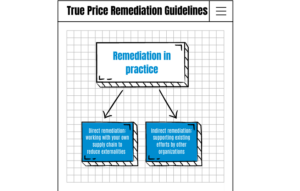Amsterdam, October 10, 2024 – Blog: Upcoming remediation guidelines for true pricing
Blog post written by: Pietro Galgani & Estefania Marti Malvido
Last month, the New York Times used our data in a story about the hidden environmental costs of food. This article brought to light the work we have been doing at True Price for over 10 years, developing a method for calculating true costs, and showing them into our shops, with more than 50 store pilots in the past 3 years. True pricing is gaining momentum across sectors such as food catering and is increasingly visible in the media and political discussions. Dutch agencies and municipalities are now exploring how true pricing can influence public procurement, and schools are incorporating it into their economics and marketing curricula.
Why are we launching guidelines about true price payments?
As true prices become more visible, we start receiving the question: Can these true prices actually be paid? Why should we do it? How does that look like, and how do you safeguard integrity? To answer these questions, we have been working on a new set of guidelines, the Remediation Guidelines for True Pricing. These guidelines provide a clear framework to ensure that true price payments are used effectively and transparently to address the social and environmental harm that comes from the products we buy and sell.
The concept of remediation
Our vision of paying the true price is based on the concept of remediation, just like our accounting methodology. When we calculate the gap between the market price and the true price, we base it on the costs of remediating any social or environmental damage caused by producing a product. This is inspired by the 2011 UN Guiding Principles on Business and Human Rights (UNGPs), which state that businesses must respect human rights, and if they are violated, remediation should be provided. In this context, remediation means making things right, or as close to right as possible.
This is at the core of what we call our rights-based monetisation approach. It allows us to show human rights and labour rights violations—harms that should never have occurred—next to the environmental costs and the price of a product, thus making it possible to communicate in a language we all understand, that of prices.
True prices to fund remediation initiatives
As true prices show the remediation costs, this means that paying the true price for a product should not only cover the production costs but also a proportion of the cost of remediating the social and environmental damage it caused. This can be done by individuals and organisations alike, as the burden can be shared between businesses, investors, communities and individuals who can afford to do this. Paying the true price may seem like a small step—maybe an extra 20 or 30 cents on a purchase transaction, which doesn’t change much in the big scheme of things. But when it’s adopted at scale, it can direct large sums of money where they are most needed. It also shows that there is a movement of people and organisations who want real action for a fairer and more sustainable economy, and are ready to pick up a proportionate part of the bill.
Funds can be raised for addressing social and environmental costs linked to the production and consumption of products. This can take the form of restoration, prevention, or compensation for the harm done. Our upcoming Remediation Guidelines say that if a company or organization asks people to pay the true price and collects funds to fix problems, they must guarantee transparency regarding where the money goes, who decides how it is used, and what impact it has. The guidelines will describe what remediation initiatives can be funded by true price payments, as well as the key elements a remediation project should include.
Two approaches to Remediation: Direct and Indirect
In practice, we see that remediation can take two main directions:
- Direct remediation involves working with your own suppliers and their suppliers, to improve environmental and social circumstances. It is the most impactful way to set up remediation initiatives because it builds on commitment and collaboration in the value chain.
- Indirect remediation means supporting existing efforts by other organisations on these issues in the sourcing region. It is a type of remediation that can be set up most easily, when direct remediation is not immediately possible, but it should not be seen as a substitute for taking other forms of action to reduce social and environmental costs.
Both approaches can help tackle products’ hidden costs, and these distinctions are central to our Remediation Guidelines in True Pricing. We emphasize that restoration and prevention should be prioritized over compensation. This is in line with updated OECD Guidelines (2023) which say enterprises should prioritize eliminating or reducing sources of emissions over offsetting, compensation or neutralization measures.
Part of the solution
True price payments can empower large and small organisations, individuals and communities to act upon their duty to care about the social and environmental impacts of the products they buy and sell. This said, we also want to stress this is only one part of the solution. . The existing crises of inequality, biodiversity and climate change, require systemic action from companies, investors, governments, and communities. Businesses must focus on offering more sustainable products, improving environmental performance, and enhancing working conditions across their value chains. Investors should reward sustainable and inclusive practices, while policymakers need to facilitate the internalization of external costs through regulation and fiscal instruments.
While we work towards this transition, true price payments can be a powerful tool to create funds and support more sustainable and equitable economies.
If you would like to learn more about joining a remediation initiative or implementing true price payments in your business, we encourage you to reach out to us at pietro@trueprice.org or estefania@trueprice.org
Subscribe to our newsletter for updates on the launch of the Remediation Guidelines.
Thank you for reading!

Pietro Galgani
Pietro Galgani is R&D Manager and leads the Data and True Price method development work | pietro@trueprice.org

Estefania Marti Malvido
Estefania Marti Malvido is the True Price Project and Partnerships Manager | estefania@trueprice.org


